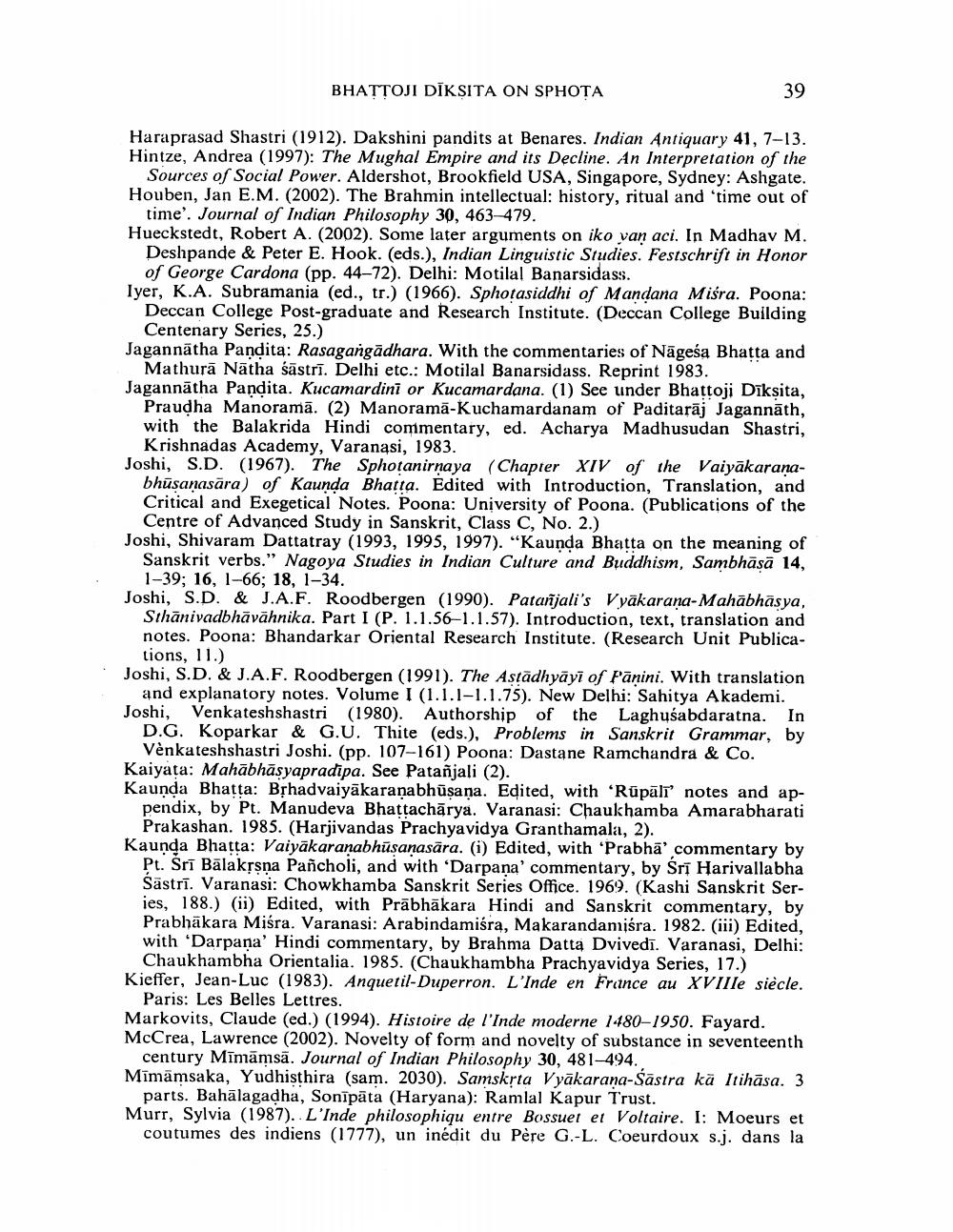________________
BHATTOJI DĪKSITA ON SPHOTA
39
Haraprasad Shastri (1912). Dakshini pandits at Benares. Indian Antiquary 41, 7-13. Hintze, Andrea (1997): The Mughal Empire and its Decline. An Interpretation of the
Sources of Social Power. Aldershot, Brookfield USA, Singapore, Sydney: Ashgate. Houben, Jan E.M. (2002). The Brahmin intellectual: history, ritual and 'time out of
time'. Journal of Indian Philosophy 30, 463–479. Hueckstedt, Robert A. (2002). Some later arguments on iko van aci. In Madhav M.
Deshpande & Peter E. Hook. (eds.), Indian Linguistic Studies. Festschrift in Honor
of George Cardona (pp. 44-72). Delhi: Motilal Banarsidass. Iyer, K.A. Subramania (ed., tr.) (1966). Sphotasiddhi of Mandana Miśra. Poona:
Deccan College Post-graduate and Research Institute. (Deccan College Building
Centenary Series, 25.) Jagannātha Pandita: Rasagangādhara. With the commentaries of Nāgeśa Bhatta and
Mathurā Nātha śāstrī. Delhi etc.: Motilal Banarsidass. Reprint 1983. Jagannātha Pandita. Kucamardini or Kucamardana. (1) See under Bhattoji Dīksita,
Praudha Manoramā. (2) Manorama-Kuchamardanam of Paditarāj Jagannath, with the Balakrida Hindi commentary, ed. Acharya Madhusudan Shastri,
Krishnadas Academy, Varanasi, 1983. Joshi, S.D. (1967). The Sphotanirnaya (Chapter XIV of the Vaiyakarana
bhūsaņasāra) of Kaunda Bhatta. Edited with Introduction, Translation, and Critical and Exegetical Notes. Poona: University of Poona. (Publications of the
Centre of Advanced Study in Sanskrit, Class C, No. 2.) Joshi, Shivaram Dattatray (1993, 1995, 1997). "Kaunda Bhatta on the meaning of
Sanskrit verbs." Nagoya Studies in Indian Culture and Buddhism, Sambhāsā 14,
1-39; 16, 1-66; 18, 1-34. Joshi, S.D. & J.A.F. Roodbergen (1990). Patanjali's Vyakarana-Mahābhāsya,
Sthānivadbhāvähnika. Part I (P. 1.1.56-1.1.57). Introduction, text, translation and notes. Poona: Bhandarkar Oriental Research Institute. (Research Unit Publica
tions, 11.) Joshi. S.D. & J.A.F. Roodbergen (1991). The Astādhyāyi of Panini. With translation
and explanatory notes. Volume I (1.1.1-1.1.75). New Delhi: Sahitya Akademi. Joshi, Venkateshshastri (1980). Authorship of the Laghuśabdaratna. In
D.G. Koparkar & G.U. Thite (eds.), Problems in Sanskrit Grammar, by
Venkateshshastri Joshi. (pp. 107-161) Poona: Dastane Ramchandra & Co. Kaiyata: Mahābhāsyapradīpa. See Patañjali (2). Kaunda Bhatta: Bịhadvaiyakaraṇabhūsaņa. Edited, with 'Rūpālī notes and ap
pendix, by Pt. Manudeva Bhattachārya. Varanasi: Chaukhamba Amarabharati
Prakashan. 1985. (Harjivandas Prachyavidya Granthamala, 2). Kaunda Bhatta: Vaiyakaranabhūsanasāra. (i) Edited, with 'Prabhā' commentary by
Pt. Srī Bālakṣsna Pancholi, and with 'Darpana' commentary, by Sri Harivallabha Sästrī. Varanasi: Chowkhamba Sanskrit Series Office. 1969. (Kashi Sanskrit Series, 188.) (ii) Edited, with Prābhākara Hindi and Sanskrit commentary, by Prabhakara Miśra. Varanasi: Arabindamiśra, Makarandamiśra. 1982. (iii) Edited, with 'Darpana' Hindi commentary, by Brahma Datta Dvivedī. Varanasi, Delhi:
Chaukhambha Orientalia. 1985. (Chaukhambha Prachyavidya Series, 17.) Kieffer, Jean-Luc (1983). Anquetil-Duperron. L'Inde en France au XVIIIe siècle.
Paris: Les Belles Lettres. Markovits, Claude (ed.) (1994). Histoire de l'Inde moderne 1480–1950. Fayard. McCrea, Lawrence (2002). Novelty of form and novelty of substance in seventeenth
century Mīmāmsā. Journal of Indian Philosophy 30, 481-494. Mīmāmsaka, Yudhisthira (sam. 2030). Samskrta Vyākarana-Šāstra kā lihāsa. 3
parts. Bahālagadha, Sonīpāta (Haryana): Ramlal Kapur Trust. Murr, Sylvia (1987). L'Inde philosophiqu entre Bossuet et Voltaire. I: Moeurs et
coutumes des indiens (1777), un inédit du Père G.-L. Coeurdoux s.j. dans la




